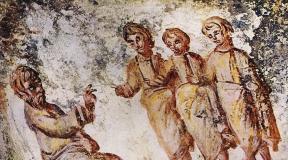Pantheon and calendar. Babylonian Zodiac. Cult calendar of the Sumerians Sumerian calendar
One of the earliest civilizations was Sumerian. The Sumerian state emerged three thousand years BC in Mesopotamia (translated from Greek as Mesopotamia), on a narrow strip between the Tigris and Euphrates rivers, where Iraq is now located. Flooding every spring, the rivers brought fertile silt to the field. But in the summer, due to the unbearable heat, the earth became hard as stone and farmers had to build irrigation canals to store water for irrigation. The emerging Sumerian calendar was associated specifically with agriculture.
The annual starting point was the spring flood of the Euphrates, after which work in the field began. Between the two floods, the same cycle took place: spring, unbearable summer heat, followed by relative coolness, and a new river flood. They were already able to judge the approach of a particular period by the celestial bodies. In Sumer, for the first time, they thought about how to divide the time between the two floods of the Euphrates into equal periods.
For a very long time, the only natural measure of time was the day, known from primitive times. However, the day is short, and to take into account longer periods of time, some other measure was needed. This is what the Sumerian priests identified by observing the Moon. Sumerian priests calculated how many days passed between two new moons. It is not easy to establish this accurately without astronomical instruments. However, they received an average result - about 29.5 days. This segment became the new measure of time - month .
In many languages of the world, to this day, both the Moon and the twelfth part of the year are called a month. For convenience, the priests rounded the month to a whole day. But, in order to equalize the overall count, they decided that in one month there would be 30, in the next - 29, then again 30, etc. And the priests also calculated that about 12 “moons” pass between the two floods of the Euphrates. So, two millennia BC, Sumer began to use a 12-month lunar calendar. According to him, the New Year began when a month first appeared in the sky in the spring. Just at that time, the water in the Tigris and Euphrates began to rise, and after half a month they overflowed. But it soon became clear that the lunar calendar seemed to be ahead of natural events. The flood of the Euphrates began later and later than the New Year holiday. According to the lunar calendar, it turned out that there are 354 days in a year, but in fact there are 11 more. But the priests of Sumer did not yet know exactly how long a year lasted. And they had to improve the calendar - approximately every three years, add another 30 day to the 12 months. This was not very convenient, and besides, such a calendar slowly diverged from nature. Still, it was a good help for farmers.
The Sumerian lunar calendar is the oldest of the currently known Sumerian calendars and the simplest, because the movement of the Moon in the sky is the easiest to observe. It first appeared in Mesopotamia, on the territory of modern Iraq, in the city-states of the ancient Sumerians in the third millennium BC.
For their time, the Sumerians were a very educated people. They had writing: they wrote with pointed sticks on clay tablets. It is the Sumerians who are considered the inventors of the wheel, plow and sickle.
The year of the Sumerian calendar consisted of 12 “moons”, that is, months. The length of the month was determined by the full cycle of changes in the lunar disk from new moon to new moon and was approximately 29.5 days. 29.5 x 12 = 354 days.
The lunar year was shorter than the solar year, and the Sumerian calendar did not coincide with the natural change of seasons. But the length of the solar year was not yet known, and therefore sometimes it was necessary to insert an additional thirteenth month into the calendar. Each Sumerian city had its own calendar, and the urban population independently coped with the difficult task of keeping track of time.
Sumerian calendars consisted of two half-years - Enten (cold and wet season) and Emesh (dry and hot season) and 12 months. In Sumerian times, seasons were not distinguished. To equalize the lunar and solar cycles, every few years after one of the half-years, a thirteenth month was inserted, which was either VI-II or XII-II. The year began in the spring, after the first new moon, which followed the flood of the rivers. Spring was marked by two events - the barley harvest and the so-called. "carp flood" Calendars are known from the Sumerian cities of Nippur, Ur, Lagash, Umma, Uruk (partially), Adab. Information about them came from ancient documents of the 3rd millennium BC. They mention the names of the months, the days of the months and lists of sacrifices for various holidays. Sometimes there are names of rituals. The only calendar, the months and rituals of which are reflected in the comments, comes from the city of Nippur. The first mention of this calendar dates back to the era of the Ummian ruler Lugalzaggesi (late 24th century). However, all commentaries date back to either Middle Babylonian (XVI-XI centuries) or Neo-Assyrian (VIII-VII centuries) times. The Nippur calendar consisted of the following months:
- Barag-zag-gar-ra "throne of the sanctuary"
- Gud-si-sa "directing the oxen (to plowing)"
- Sig-u-shub-ba-gar "placing a brick in a brick mold"
- Shu-numun-a "month of sowing"
- Easy-easy-gar-ra "month of lighting the lights"
- Kin-Inanna "month of the rite of the goddess Inanna"
- Dul-Kug "month of the Sacred Hill"
- Apin-du-a "month of releasing the plow (from the arable land)"
- Gan-gan-ed "the month of the Killer's release"
- Ab-ba-ed "month of fathers coming out"
- Ziz-a "month of double grain or spelt" (month of darkness)
- She-gur-kud "month of harvest"
When the Sumerian cities were conquered in the 2nd millennium BC by the Babylonian kingdom, the then reigning king Hammurabi ordered that the calendar of the city of Ur be considered common to all Sumerians and Babylonians. He was probably better than everyone else.
New Year is the most favorite holiday of all peoples. How did he appear on Earth and what are the true reasons for such popular love for him?
The dying and resurrected god is a widespread mythological archetype, found in almost all religions. A number of researchers associate this myth with Atlantis and its legacy. As a rule, not only secret mysteries (initiations), but also all kinds of folk festivals and rituals are associated with it. Such are the Egyptian mystery about the death and rebirth of Osiris, the mourning of Hylas among the Keos Greeks and Adonis in Cyprus and Lesbos, the Eleusinian mysteries, as well as the Slavic customs related to these rites of the “funeral of Kostroma” and the burning of Maslenitsa. The Risen Christ traces his ancestry to these dying and rising gods.
Christmas Day, which falls on December 25th, also has Babylonian/Sumerian roots. The real birthday of Jesus is unknown, but in order to satisfy a large part of society, Emperor Constantine the Great, who established Christianity as the official religion of Byzantium, ordered Christmas to be celebrated on the day on which the birth of the sun god Mithras was previously celebrated, and before him the Babylonian Dimuz (husband of Inanna / Ishtar) .
It is generally believed that the dying and rising god is a personification of the forces of nature and fertility, he “dies” in the fall and “resurrects” with the arrival of spring. However, this myth has a deeper purpose, which is to show evolving man the path of Spirit (which he/she is) descending into Matter.
7. New Year, Ivan the Terrible and Nibiru
Nibiru, Ivan the Terrible and the title "Tsar"
In the ancient world there was no clear boundary between the world of people and the world of gods. In the East, where the first civilizations were created, theocratic monarchies existed for thousands of years in which the king was either a god (as in Egypt) or a servant of a god (as in Mesopotamia).
Ivan the Terrible was the first Russian ruler to take the title "Tsar", i.e. Supreme Ruler. All previous sovereigns bore the title only "Grand Duke", implying that above them were the Mongol khans (who were paid tribute) and the Byzantine emperors (from whom they accepted Christianity).
 Until now, the origins of the word “Tsar” in the Russian language are not known for certain. No matter how fantastic it may sound, the closest in pronunciation and meaning is the Sumerian word “Sar”, which is an epithet of Nibiru - the home planet of the Sumerian gods who created man. The word "Sar" means "Supreme Ruler", i.e. "King". This is where the roots of the Middle Eastern name Sarah/Sarah meaning "Lady" come from. This was the name of the wife of Abram / Abraham, who, at the request of God, together with her husband, changed their Sumerian names to new ones, and from which many peoples and monotheistic religions came - Judaism, Christianity, Islam.
Until now, the origins of the word “Tsar” in the Russian language are not known for certain. No matter how fantastic it may sound, the closest in pronunciation and meaning is the Sumerian word “Sar”, which is an epithet of Nibiru - the home planet of the Sumerian gods who created man. The word "Sar" means "Supreme Ruler", i.e. "King". This is where the roots of the Middle Eastern name Sarah/Sarah meaning "Lady" come from. This was the name of the wife of Abram / Abraham, who, at the request of God, together with her husband, changed their Sumerian names to new ones, and from which many peoples and monotheistic religions came - Judaism, Christianity, Islam.
The Sumerians used the word “Sar” to refer to the period of rotation of Nibiru around our Sun, which is 3600 years and is also translated as “right circle” or “full cycle”. The Sumerians designated the number 3600 using an icon in the form of a large circle (or orbit). Among the Sumerians, these three terms are identical: the planet Nibiru, its orbit, the number 3,600. The term “Sar” itself, like other astronomical knowledge, the Sumerians received from the Nibiruans, who were not only their gods, but also teachers.
 The main holiday that these gods left to earthlings was the New Year, dedicated to the creation of man by the Nibiruans. When humanity proved its maturity, they began to appoint the most capable people as rulers over other people and cities. Ishtar was responsible for the appointment of kings in Mesopotamia for a long time.
The main holiday that these gods left to earthlings was the New Year, dedicated to the creation of man by the Nibiruans. When humanity proved its maturity, they began to appoint the most capable people as rulers over other people and cities. Ishtar was responsible for the appointment of kings in Mesopotamia for a long time.
 The royal prayer place of Ivan the Terrible in the Assumption Cathedral of the Kremlin stands on wooden lions. Sumerian gods (Nibiruans) were depicted on the same lions. The royal place of prayer - the Monomakh Throne - was created in 1551 for the first Russian Tsar Ivan the Terrible, in the year of the founding of Sviyazhsk (see the work “The Lotus Blooming in Russia”).
The royal prayer place of Ivan the Terrible in the Assumption Cathedral of the Kremlin stands on wooden lions. Sumerian gods (Nibiruans) were depicted on the same lions. The royal place of prayer - the Monomakh Throne - was created in 1551 for the first Russian Tsar Ivan the Terrible, in the year of the founding of Sviyazhsk (see the work “The Lotus Blooming in Russia”).
Through Ivan the Terrible, not only the attributes of the power bestowed by the Nibiruans came to Rus', but also geographical places associated with the New Year, the main holiday that the gods from Nibiru left to earthlings, appeared. Thus, the first Russian Tsar Ivan the Terrible, back in the 16th century, bestowed the status of “Great” (in the sense of almost “Sar”) on Ustyug, which in the 20th century became the birthplace of Father Frost and the New Year, in which all of Mesopotamia celebrated the creation of man by the Nibiruans. Moreover, the first wife of Ivan the Terrible was Anastasia from the family of Procopius the Righteous (see the work “The Secret of the Romanov Family”), the Ustyug miracle worker.
Under Ivan the Terrible, Lovozero appeared for the first time in Russian chronicles - the current capital of Russian Lapland in the Murmansk region, the sister of Finnish Lapland - the homeland of Santa Claus. Murmansk itself, formerly Romanov-on-Murom is located on the 33rd meridian, next to the Nile meridian (30th meridian), on which St. Petersburg, Constantinople (Istanbul), Alexandria of Egypt, the pyramids of Giza, etc. are located.
 On the 33rd meridian in Sevastopol there is a pyramid temple, where, according to some researchers, the last Russian Tsar hid his royal regalia - a crown and a scepter. 33 degrees is also the angle of Nibiru’s orbit to the plane of the planets of the solar system.
On the 33rd meridian in Sevastopol there is a pyramid temple, where, according to some researchers, the last Russian Tsar hid his royal regalia - a crown and a scepter. 33 degrees is also the angle of Nibiru’s orbit to the plane of the planets of the solar system.
Nibiru, Ivan the Terrible and the Life-Giving Cross
The angle of Nibiru's orbit to the plane of the planets of the solar system is about 33 degrees. Hence, the second name of Nibiru is as a Planet or a place of intersection, crossroads. Ancient symbol of Nibiru - cross. Almost as life-giving as the one about which Ivan the Terrible spoke in the film “Ivan Vasilyevich Changes His Profession.”
"That's what cross the life-giving one does!”
Nibiru, Ivan the Terrible and Monomakh's Cap
 The distinctive sign of the Nibiruan gods was a headdress - a symbol of supreme power, which in Rus' became the Monomakh's cap - the most revered attribute of royal power and the personification of the king's responsibility to his subjects. This is exactly what A.S. Pushkin hints at, in the words of Boris Godunov: “Oh, you are heavy, Monomakh’s hat.”
The distinctive sign of the Nibiruan gods was a headdress - a symbol of supreme power, which in Rus' became the Monomakh's cap - the most revered attribute of royal power and the personification of the king's responsibility to his subjects. This is exactly what A.S. Pushkin hints at, in the words of Boris Godunov: “Oh, you are heavy, Monomakh’s hat.”
Thus, the power of the Moscow sovereigns receives its supreme sanction not so much from the Byzantine emperors, but from the Babylonian king Nebuchadnezzar II himself, who built the famous Ishtar Gate - one of the main symbols. Through this symbol, the heritage of the Sumerians (Nibiruans) passed into Judaism, Christianity, Islam, which played a key role in the development of our civilization in the last thousand years.
Science: “The Sumerian calendar is a prototype of the Ural calendar.” Well, yes, because Uralic is thousands of years older... September 25, 2017
Shigir idol - Varuna calendar
Lokamanya Bal Gangadhar Tilak
In 1903, the Indian Sanskrit scholar and public figure Lokamanya Bal Gangadhar Tilak published the book “The Arctic Homeland in the Vedas,” in which he cited a number of scattered information from the Rigveda, Samhita and Avesta, indicating the existence in ancient times northern calendar, which once became a kind of basis for the appearance of the hymns of the Rig Veda and the most ancient layers of mythology of the Eurasian peoples.
According to Tilak, near the polar regions there once existed an archaic calendar, which was used, among other things, by the Indo-Aryan tribes, who preserved descriptions of this calendar in the form of Vedic mythology and sacrificial rites.
In European historiography, few people paid attention to this unique book, as well as to Tilak’s first book, Orion, or a Study of the Antiquity of the Vedas (1893), where the European periodization of the Vedas was refuted, according to which the hymns of the Rig Veda were composed around 2400 BC.
However, as Tilak was able to show, the Vedic descriptions of the constellation Orion (Mriga), with which the date of the vernal equinox relates, correspond to the position in which this constellation was around 4500 BC.
In other words, the first compilers of Vedic hymns lived two thousand years earlier than what was spoken of in Europe. Therefore, the mythological tradition on which the Vedic rishis relied was even older, or rather extremely ancient, in fact, going back to the Ice Age.
In general, historians treated Tilak's theory with great distrust.
Firstly, according to prevailing ideas, the origin of human civilization it is customary to attribute to Ancient Sumer and Egypt, from where knowledge and the lunisolar calendar gradually reached the Ido-European tribes.
And secondly, you never know what the Brahmins could have been singing for thousands of years, transmitting from word to word certain texts that had become incomprehensible to them. However, three years before the publication of Tilak’s Orion, that is, back in 1890 (!), in the Urals near the peat bogs of the city of Kalata (Kirovgrad), a five-meter wooden idol was found, which turned out to be an invaluable monument of cultural heritage.
A brief history of the discovery of the idol and disputes over the dating of the artifact can be read in Polina Vinogradova’s article “Great-Grandfather of the Pyramids.” 1
Only in 2014, a group of German specialists, together with Uwe Heusner and Thomas Terberger, finally managed to establish the most probable time of creation of the Shigir idol. As it turned out, it stood in the Urals 11 thousand years ago, at the turn of the last glaciation - thousands of years before the civilizations of Mohenjo-Daro, Sumer and Ancient Egypt.
This dating in itself is already a sensation! Currently, the Shigir idol is considered the most archaic wooden sculpture in the world.
However, the meaning of the chain design carved into the wood is still unclear. According to the completely logical assumption of the first researchers of the sculpture, it was a calendar, since the notches and strokes were applied to the wood according to a well-thought-out, pre-known pattern.
However, after the discovery of the eighth face on the Shigir idol, for some reason some archaeologists immediately rushed to reject the version of the calendar, without offering anything in return. Like, if there are not seven faces, but eight, then there is no connection with the calendar of Ancient Sumer.
But who said that the Sumerian calendar was the prototype of the Ural calendar?
Where does this conviction come from that the first lunisolar calendars could only have been compiled in Egypt or Mesopotamia?
Such a prejudiced attitude towards the Shigir idol can, perhaps, be explained only by the fact that it is simply inconvenient. It clearly testifies to the fact that in the north there lived not savages who could barely count on their fingers, but that there was some kind of civilization and culture. Therefore, no one explains the meaning of the mysterious marks for the elementary reason that it is unprofitable within the framework of the existing historical paradigm.
In fact, if scholars had shown any interest in the Rig Veda and read “ anti-scientific"Tilak's book, they would have long ago discovered the correspondence of the Shigir idol to the northern calendar, the reconstruction of which Tilak was engaged in with incredible persistence; he himself would have found a correspondence if he had known about this find.
Shigir idol and ritual notches in the form of “ chain circuit"(9 thousand years BC)
At the top on the front side of the Shigir idol there are 25 strokes - according to the number of Vedic dawns, from which in the ancient era " pura kalpu"The year and creation began: " The Creator created at five (dawns), giving each of the five five sisters" 2
Just below you can see 12 curved lines, grouped by 5 and 7 - five cold months and seven sunny months - just such an initially two-season division of the year that Tilak insisted on, since the ancient year " had one head but two mouths" 3
Tilak explained the two-season division of the year by the polar night and polar day, however, in the latitudes of the Urals, winter nights are long enough for the same two-season to be clearly distinguished.
Next on the idol are 28 notches - four chains of the lunar cycle of 7 days each. Multiplying 12 months by 28, we get 336 days, plus 25 initial dawns - a total of 361 days, after which, as we see, 3 more strokes are added - exactly the number of days in the ceremony " pravargya" before the annual " revival» sun (Surya). 4
In short, the essence of the ritual was the preparation of the seed of the sun, which should germinate or “ be reborn"after the winter solstice.
Thus, there are a total of 364 main days plus the day of germination of the sun (Surya), whose face is depicted below.
Above his head there are eight notches, and under his face there are three more strokes, which can only mean that once every eight years “ revival“Surya was celebrated not one, but three days in a row.
The difference compared to our regular calendar is that every four years we add one extra day to 365, whereas in " pura kalpu"(more than 11 thousand years ago), two days were added to 365 days every eight years, since the astronomical year is approximately 365 ¼ days.
The period of sacrifices in that primary era " purvyam yuga" lasted 10 months " Dasha masses“- and on the Shigir idol, chains of 10 notches are clearly visible, clearly demonstrating the difficulty that commentators of the texts of the Rig Veda and Atharva Veda often faced: why are the sons of heaven Agnirasa were described as " having seven mouths", how " having ten mouths" 5
The likelihood that these are just random numerical coincidences is negligible, since the idol was directly associated with the cycles of sacrifices, for the calculation of which a calendar system or order is needed (Vedic Rta, Rita), the guardian of which was the asura Varuna, holding an inverted tree with its roots in unsupported space (RV, I, 24). 6
But this cosmic order Rta was not some ephemeral order, it was a very specific and strict sequence of sacrifices to the gods, which was carved on a tree in the form of the idol of Varuna Jambuka (“ Tree of Varuna»).
Complex calculation of sacrifices, including soma libations " hundredfold"God Indra" shata-krata"), lasting from 13 to 100 nights (the so-called tradition Gavam-ayanam, which literally translates as “ cow path), just given on the rest of the calendar.
Echoes of this calendar tradition were preserved in ancient Greek culture, although the Greeks themselves, of course, hardly knew where the tradition of sacrificing hundreds of bulls came from (“ hecatomb»).
Vedic Varuna for the ancient Greeks had long ago turned into the god Uranus, who had lost his supremacy, and whom Cronus castrated in time immemorial. And with etymology Varuna = Ouranos Almost all Indo-Europeanists agreed, including Max Müller, as well as the Russian commentator on Theogony, Georgiy Vlastov. 7 Both of these gods, Uranus and Varuna, were autocratic gods of the sky, both were mystically associated with the earth and lost power as a result of the loss of male power.
Vedic cosmogony in the form of a simplified diagram
In other words, there is every reason to believe that the Shigir idol is the Varuna calendar, the same heavenly order Rta, which, according to the mythological ideas of the Proto-Indo-Europeans, determined the movement of time, the sun, moon, stars and planets, as well as the change of seasons - cold winter and relatively warm summer, consisting, as Tilak wrote in his book, of seven solar months or Adityev, about which the Rig Veda (RV, X, 72) says: “ Aditi has eight sons, who were born from (her) body. With seven she joined the gods, and threw Martanda away" 8
It is worth noting once again that the lunisolar calendar of 364 days plus 1 day and plus 3 days after every eight years is the most clear explanation “ chain circuit
A very important aspect of the cult is holidays. The holidays were not the same everywhere; the Greeks did not even agree on the names of the months; The Athenians, like the Ionians in general, dated the beginning of the year to coincide with the summer solstice, the Dorians, probably, to the autumn equinox, and the Aeolians, to the winter solstice.
And here we are only familiar with any certainty with the Athenian holiday calendar; in other places we know only individual holidays. There is no doubt that the Athenian holidays were the most famous:...
In Iraq, on the territory of ancient Mesopotamia, in 1992, archaeologist John Olrim discovered three rare crystal lenses, which caused great bewilderment in scientific circles. It was not possible to date the age of this find using the archaeological chronogram method.
For some unknown reason, all research into the mysterious lenses was stopped. There were rumors that the ancient artifact was being studied by a NASA chemical laboratory, other sources said that the lenses were kept in the Vatican, which strictly...
Ancient Siberian ghost towns - before the arrival of Ermak. Curious information about ancient settlements that existed in Siberia and Altai even before the mass arrival of Russian people here has for some reason been deprived of the attention of historians, archaeologists and other specialists. Is Siberia not a historical land?
The assessment of Siberia as a “non-historical land” was first given by one of the creators of the notorious “Norman theory,” a German in Russian service, Gerard Miller. In the “History of Siberia” and “Description of the Kuznetsk district of Tobolsk...
Sumerians
Region of residence - Middle East
The process of the formation of large political units from small urban areas in Babylonia and Egypt can now be presented in general terms. In the Asian Mesopotamia, along with it, an important process of interaction between two elements of the population - the Sumerians and Semites, and then the Semites of various strata - took place before the eyes of history.
Urban temple centers with local rulers and cults were centers of culture, religion and government. On South...
The Ivan Kupala holiday will be held for the first time in the Tsar's estate Izmailovo near the Bridge Tower on the shore of the Serebryano-Vinogradny Pond, the press service of the Moscow State United Museum-Reserve told Interfax today.
On June 24 at 20:00, everyone will be able to take part in ancient Kupala rituals - pouring water, fortune telling with wreaths, choosing “bride and grooms”, dancing, round dances, jumping over a fire, and also listen to ancient Russian songs...
Red Hill is a holiday that includes both folk and church traditions. It has many alternative names, all of which are relevant.
Priests recommend that Orthodox people call Krasnaya Gorka St. Thomas Sunday.
The name Antipascha is also common: it is translated as “a day instead of Easter” and recalls the Resurrection of Christ, which occurred a week ago, calling on believers to once again rejoice in the miracle. In any case, this is an important day for all Orthodox Christians...
Every year on January 25, the Orthodox people celebrate Tatiana's Day. Another holiday is celebrated on this day - Student's Day. Many students consider Saint Tatiana their patroness and intercessor. So who is she?
It turns out that Tatyana’s day originates in the era of the birth of Christianity.
On this holiday, all believers pay homage to Saint Tatiana, the patroness of knowledge. The Roman martyr suffered for her faith. At that distant time, she bore the name Tatiana, which is translated from Greek...
Easter is the most important Christian holiday dedicated to the miraculous Resurrection of Jesus Christ. A long-awaited religious event will soon take place, which every Orthodox believer must know about.
The most important and long-awaited event in the church calendar is Easter.
The Day of the Resurrection of Christ is dedicated to the victory of eternal life over death and is currently celebrated by both Orthodox believers and Catholics. In many countries, this holiday is one of the state and...


















